You might imagine that it would be difficult to remove a heavy adult from a swimming pool, but with practice and the proper equipment it’s not.
(See also: How to rescue a drowning victim using a reaching assist or a shepherd’s crook)
I am leaving this description of a two-lifeguard method of removing a victim from a swimming pool, because I still teach it to non-lifeguards, as it is easier for them to learn and much easier to do than the current Red Cross extractions from a pool.
For the (copyrighted 2016, released 2017) version go to the Lifeguarding Manual, available for a free download at:
http://embed.widencdn.net/pdf/plus/americanredcross/jhlpoovbxz/LG_PM_digital.pdf?u=xm9usb
and look at pages 185-189, including Extrication Using a Backboard at the Pool Edge / At the Steps / in Zero Depth / Steep Steps and/or moving water. See also: write these notes in your Lifeguard text for some advice on making these extractions easier to do.
From the American Red Cross (ARC) text Lifeguard Training:
“A victim who is unconscious or too exhausted may need to be removed from the water. Your decision to remove the victim depends on the victim’s condition and size, how soon you can expect help to arrive, and whether anyone can help you. Two lifeguards or one lifeguard and a bystander are needed to safely remove a victim from the water.”
NOTE that this is not the method for any victim you suspect of having a spinal injury. Also NOTE that this webpage is not complete training in how to perform this task.
To remove a victim the guard who did the rescue (the primary guard) moves the victim to the side and transfers the victim to a waiting guard on deck.
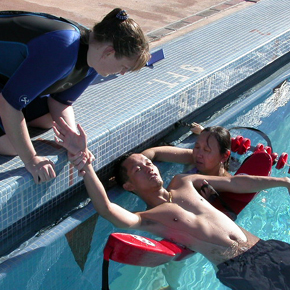
While protecting the victim’s head and keeping the victim’s face out of the water, (and their airway open if they are unconscious) the victim is made to face the side of the pool. The primary guard exits the pool, gets the backboard and slips the backboard straight down into the water.
(Note how the second lifeguard is holding the victim’s crossed wrists.) This process is much more professional if the guard on deck tells the guard in the water which side of the victim to place the backboard on. During initial practices the lifeguard candidates sometimes end up arguing with each other about board placement, moving the board from side to side, or trying to uncross and recross the victim’s wrists.
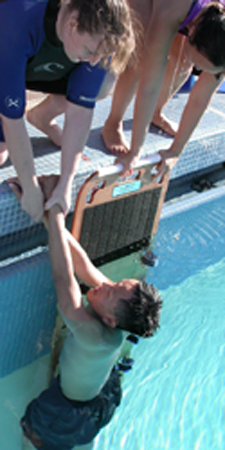
The victim is then turned onto the backboard by uncrossing the wrists.
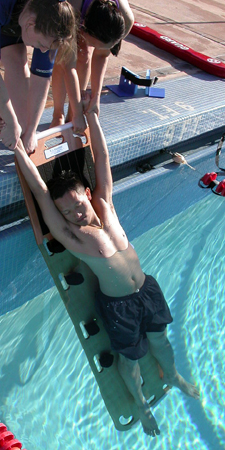
The two guards each take one wrist and one handhold on the board, and can easily slide the backboard and victim up onto the deck.
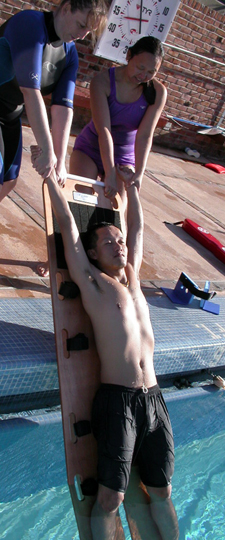
The first time you try this in class the victim may start to slide off the backboard. If you are being the victim you should be aware of what is going on in case you start to slide off and you should lift your head up slightly just as the backboard is being laid down on the pool deck in case it lands less than gently. This move goes quite smoothly once it has been practiced.
The backboard shown is a Coy Jones CJ1000 Spineboard. In our classes we use various brands and types of backboards including the Miller Board, ABS plastic backboard and plywood backboards with various strapping configurations. We also use various sizes, styles and lengths of rescue tubes or rescue cans. This way students can become connoisseurs of the best equipment.
Here’s the old method. At De Anza we still teach some of the old methods because you won’t always have the proper equipment when away from work. You won’t be carrying a rescue tube on a backpacking trip. The hotel or apartment complex pool may only have a shepherd’s crook or no formal equipment at all.
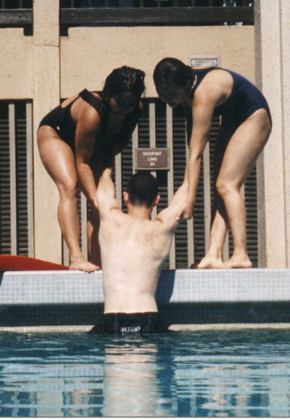
Here’s what you might look like the first time you try this in class if the board slips. (Unfortunately it is also the way it could look at your pool if your staff does not do regular in-service training.)
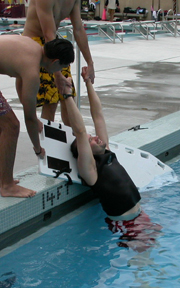
——————————————
See also: How to rescue a drowning victim using a reaching assist or a shepherd’s crook
How to rescue a submerged victim
How to pass a Red Cross written test
Emergency Action Plan for a coach or swim instructor
Neighborhood Watch applied to swim centers
The people in these photos are:
(top of page) primary rescuer, ARC lifeguard and WSI (Water Safety Instructor – the ARC swim teacher certification) Sherry Fong; second lifeguard, ARC lifeguard Susan Eaton; victim, ARC lifeguard, WSI and CPR/First Aid instructor Minh Nguyen.
(center photo of old lift) ARC lifeguards (L) Ann-Marie Urbach (who became an ARC lifeguard instructor) and (R) Yao Li lift ARC lifeguard (USN Petty Officer First Class) Tim Alston.
(bottom photo of slip) The names/identities of these lifeguard candidates are being protected.
The author of this webpage, (written as a homework reading assignment for my students), does not give any warranty, expressed or implied, nor assume any legal liability or responsibility for the accuracy, completeness, or usefulness of any information, product, or process included in this website or at websites linked to or from it. Users of information from this website assume all liability arising from such use.